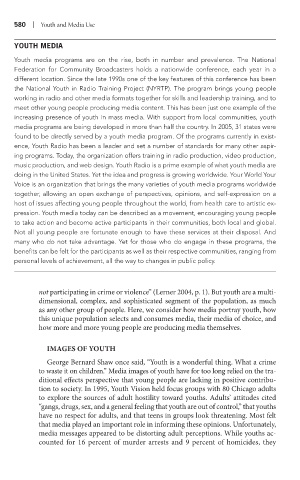Page 601 - Battleground The Media Volume 1 and 2
P. 601
0 | Youth and Med a Use
youth Media
Youth media programs are on the rise, both in number and prevalence. The National
Federation for Community Broadcasters holds a nationwide conference, each year in a
different location. Since the late 1990s one of the key features of this conference has been
the National Youth in Radio Training Project (NYRTP). The program brings young people
working in radio and other media formats together for skills and leadership training, and to
meet other young people producing media content. This has been just one example of the
increasing presence of youth in mass media. With support from local communities, youth
media programs are being developed in more than half the country. In 2005, 31 states were
found to be directly served by a youth media program. Of the programs currently in exist-
ence, Youth Radio has been a leader and set a number of standards for many other aspir-
ing programs. Today, the organization offers training in radio production, video production,
music production, and web design. Youth Radio is a prime example of what youth media are
doing in the United States. Yet the idea and progress is growing worldwide. Your World Your
Voice is an organization that brings the many varieties of youth media programs worldwide
together, allowing an open exchange of perspectives, opinions, and self-expression on a
host of issues affecting young people throughout the world, from health care to artistic ex-
pression. Youth media today can be described as a movement, encouraging young people
to take action and become active participants in their communities, both local and global.
Not all young people are fortunate enough to have these services at their disposal. And
many who do not take advantage. Yet for those who do engage in these programs, the
benefits can be felt for the participants as well as their respective communities, ranging from
personal levels of achievement, all the way to changes in public policy.
not participating in crime or violence” (Lerner 2004, p. 1). But youth are a multi-
dimensional, complex, and sophisticated segment of the population, as much
as any other group of people. Here, we consider how media portray youth, how
this unique population selects and consumes media, their media of choice, and
how more and more young people are producing media themselves.
imagEs oF youTh
George Bernard Shaw once said, “Youth is a wonderful thing. What a crime
to waste it on children.” Media images of youth have for too long relied on the tra-
ditional effects perspective that young people are lacking in positive contribu-
tion to society. In 1995, Youth Vision held focus groups with 80 Chicago adults
to explore the sources of adult hostility toward youths. Adults’ attitudes cited
“gangs, drugs, sex, and a general feeling that youth are out of control,” that youths
have no respect for adults, and that teens in groups look threatening. Most felt
that media played an important role in informing these opinions. Unfortunately,
media messages appeared to be distorting adult perceptions. While youths ac-
counted for 16 percent of murder arrests and 9 percent of homicides, they

